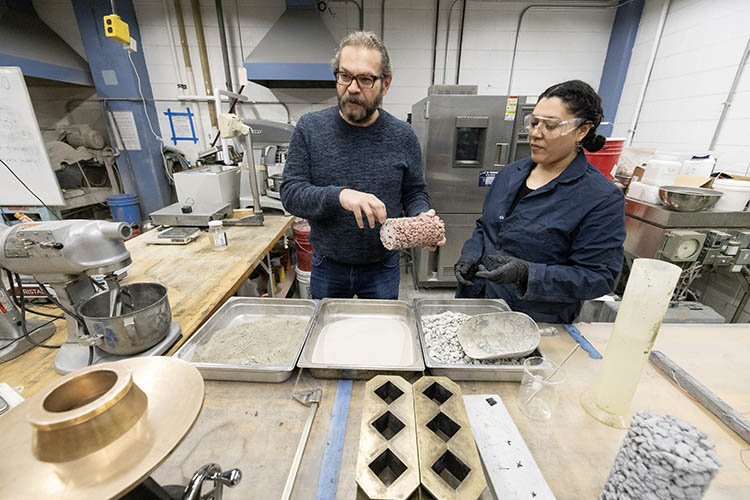
Konstantin Sobolev, UWM professor of civil engineering, and doctoral student Meraly Lopez Morales look over concrete samples made with various added materials. A new NSF-funded research center in the College of Engineering & Applied Science will research high-performance concrete and greener methods of making concrete so that industry can bring discoveries into use. (UWM Photo/Troye Fox)
UW-Milwaukee’s College of Engineering & Applied Science and Oregon State University have been selected by the U.S. National Science Foundation (NSF) to establish a research center devoted to developing new knowledge to help industry create new technologies that will dramatically improve concrete’s sustainability, durability and labor efficiency, while also bringing down its cost.
Use-inspired research will be done in collaboration with center members from the concrete industry.
The center, called the Concrete Advancement Network (CAN), is backed by a $1.5 million grant from the NSF’s Industry-University Cooperative Research Center (IUCRC) program, with matching support from industrial members of $1.5 million or more.
The center aims to solve the research challenges of getting new technologies, such as greener concrete, into use in the construction sector, according to Konstantin Sobolev, center director and UWM professor of civil engineering.
“Concrete is manufactured and used on an enormous scale,” Sobolev said. “Therefore, it is a material that consumes large volumes of resources: raw materials, energy, manpower and time. Even a modest improvement in the energy or other resources needed to produce concrete can result in a significant societal benefit and reduction of cost.”
Solutions for U.S. infrastructure
CAN is one of more than 80 IUCRCs; collectively they involve over 120 U.S. universities. IUCRCs accelerate the impact of basic academic research through relationships with industry and government leaders, closing the gap between discovery and adoption.
“The activities of the CAN are strategically important to the U.S. economy for two reasons,” said Jason Weiss, Edwards Professor of Engineering at Oregon State University. “First, it focuses on developing long-term solutions for the nation’s deteriorating infrastructure, like roads, sewers and buildings. Second, the work prioritizes reducing the global warming potential associated with cement and concrete production.”
With collaborators from Arizona State University and the University of Texas at Arlington, CAN researchers will work together on the latest advancements in nanotechnology, bottom-up engineering, recyclability, improved structural design with machine learning, and emergent application areas related to improving uses of concrete in the nation’s infrastructure.
Cement is a major carbon culprit
The solutions the research could address include methods of reducing or eliminating the cement portion of concrete – the “glue” that holds all the ingredients together and is a huge contributor of atmospheric carbon dioxide emissions. Research efforts will focus on replacing or reducing cement with materials that don’t have a heavy carbon footprint and methods of capturing carbon in concrete.
But center researchers also aim to boost concrete performance through the use of chemical admixtures, nano-modification and fiber reinforcement to achieve a range of new properties that have not previously been associated with concrete, including:
- Concrete that removes air and water pollution.
- Concrete that harvests solar energy.
- Concrete that repels water and ice, extending its service life.
- Smart concrete that can “sense” damage or deterioration.
NSF is funding this center with industry support for a five-year term, potentially renewable for five more years. Continued industry support after this period of NSF support will help the center become self-sustaining. Membership in this center is open to all U.S.-based industry as well as interested government partners.
Written by Laura Otto
Link to original story: https://uwm.edu/news/uwm-leads-new-nsf-funded-consortium-to-research-greener-high-performance-concrete/
